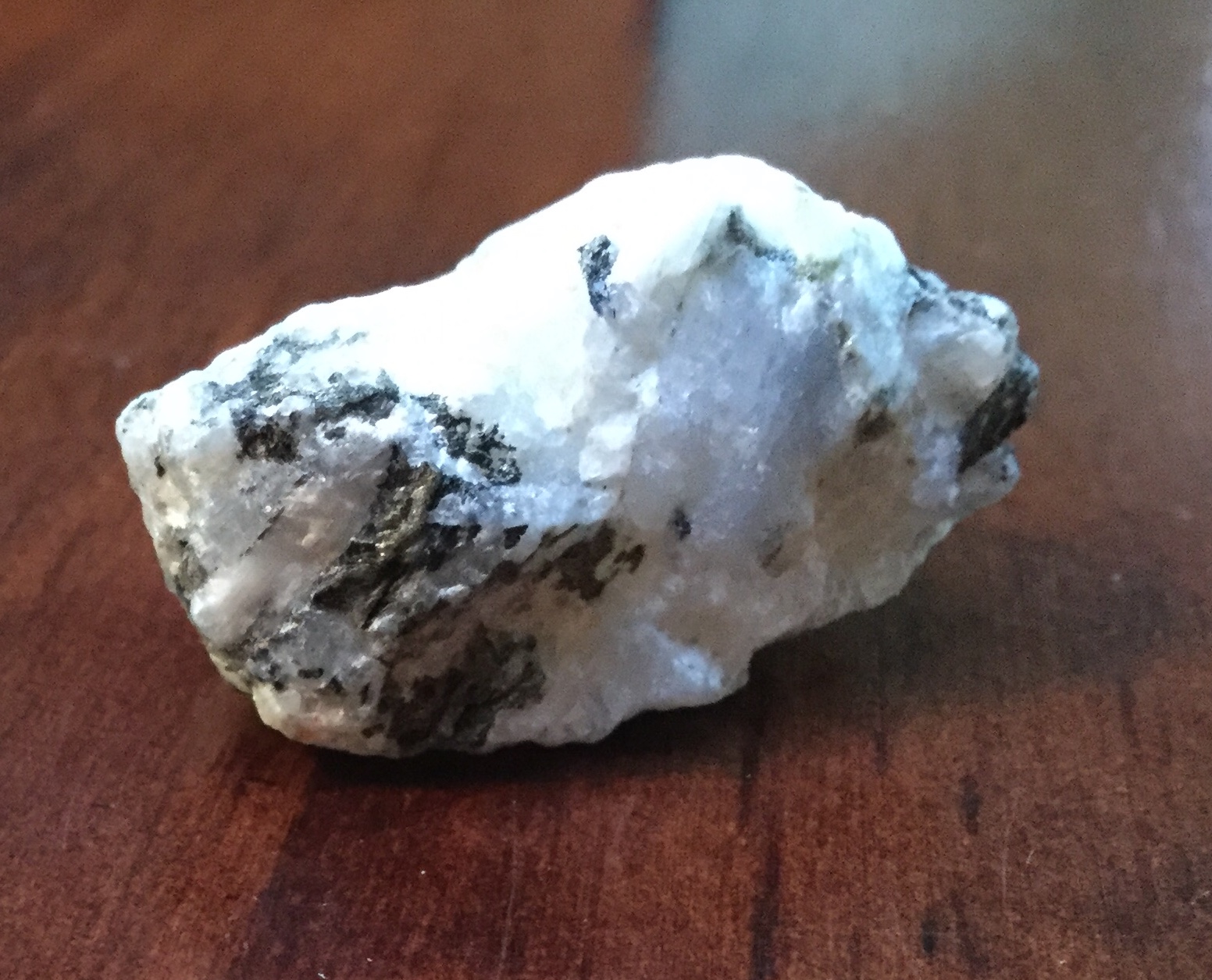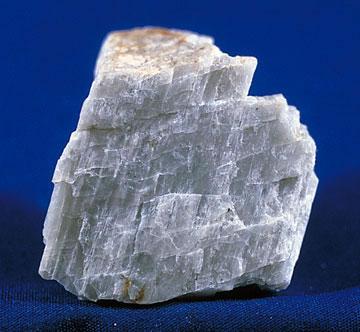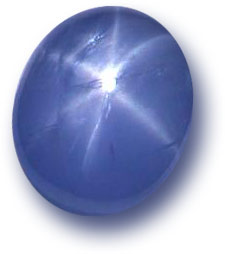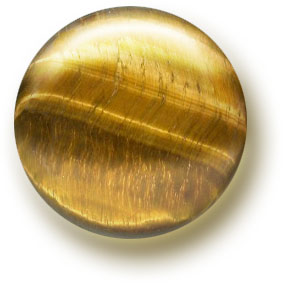|
Moonstone (gemstone)
Moonstone is a sodium potassium aluminium silicate minerals, silicate ((Na,K)AlSi3O8) of the feldspar group that displays a pearly and opalescence, opalescent Lustre (mineralogy)#Schiller, schiller. An alternative name for moonstone is hecatolite (from goddess Hecate). Etymology The name ''moonstone'' derives from the stone's characteristic visual effect, called adularescence (or schiller), which produces a milky, bluish interior light. This effect is caused by light diffraction through alternating layers of orthoclase and albite within the stone. The diffracted light varies from white to blue, depending on the thinness of the albite layers. More technically, this micro-structure consists of regular exsolution layers (lamellae) of different alkali feldspars (orthoclase and sodium-rich plagioclase). Polished moonstones often display chatoyancy ("cat's eye" effect), where a luminous streak appears through the stone. Asterism (gemology), Asterism is rare and produces four-legged ... [...More Info...] [...Related Items...] OR: [Wikipedia] [Google] [Baidu] [Amazon] |
Tectosilicate
Silicate minerals are rock-forming minerals made up of silicate groups. They are the largest and most important class of minerals and make up approximately 90 percent of Earth's crust. In mineralogy, the crystalline forms of silica (silicon dioxide, ) are usually considered to be tectosilicates, and they are classified as such in the Dana system (75.1). However, the Nickel-Strunz system classifies them as oxide minerals (4.DA). Silica is found in nature as the mineral quartz, and its polymorphs. On Earth, a wide variety of silicate minerals occur in an even wider range of combinations as a result of the processes that have been forming and re-working the crust for billions of years. These processes include partial melting, crystallization, fractionation, metamorphism, weathering, and diagenesis. Living organisms also contribute to this geologic cycle. For example, a type of plankton known as diatoms construct their exoskeletons ("frustules") from silica extracted from sea ... [...More Info...] [...Related Items...] OR: [Wikipedia] [Google] [Baidu] [Amazon] |
Type Specimen (mineralogy)
In mineralogy, the type specimen, also known as type material, is a reference sample by which a mineral is defined.Dunn, p. 1269. Similar to the biology type methods, a mineral type specimen is a sample (or in some cases a group of samples) of a mineral to which the scientific name of that mineral is formally attached. In other words, a type specimen is an example that serves to anchor or centralize the defining features of that particular mineral. A mineral is a scientifically named set that includes some materials and excludes others, based on a detailed published description and on the provision of type specimens, which are usually available to scientists for examination in a major museum research collection, or similar institution. History Whereas the system of type specimens has long-existed in the biological sciences, this is not the case in mineralogy. The recentness of the practice means that sometimes no type material exists, even for minerals discovered as recently as ... [...More Info...] [...Related Items...] OR: [Wikipedia] [Google] [Baidu] [Amazon] |
Oligoclase
Oligoclase is a rock-forming mineral belonging to the plagioclase feldspars. In chemical composition and in its crystallographic and physical characters it is intermediate between albite ( Na Al Si3 O8) and anorthite ( CaAl2Si2O8). The albite:anorthite molar ratio of oligoclase ranges from 90:10 to 70:30. Oligoclase is a high sodium feldspar crystallizing in the triclinic system. The Mohs hardness is 6 to 6.5 and the specific gravity is 2.64 to 2.66. The refractive indices are: nα = 1.533–1.543, nβ = 1.537–1.548, and nγ = 1.542–1.552. In color it is usually white, with shades of grey, green, or red. Oligoclase is a common mineral in the more silica-rich varieties of igneous rock and in many metamorphic rocks. Name and discovery The name oligoclase was given by August Breithaupt in 1826 from the , little, and , to break, because the mineral was thought to have a less perfect cleavage than albite. It had previously been recognized as a distinct species by J. J. Berzel ... [...More Info...] [...Related Items...] OR: [Wikipedia] [Google] [Baidu] [Amazon] |
Plagioclase
Plagioclase ( ) is a series of Silicate minerals#Tectosilicates, tectosilicate (framework silicate) minerals within the feldspar group. Rather than referring to a particular mineral with a specific chemical composition, plagioclase is a continuous solid solution series, more properly known as the plagioclase feldspar series. This was first shown by the German mineralogist Johann F. C. Hessel, Johann Friedrich Christian Hessel (1796–1872) in 1826. The series ranges from albite to anorthite endmembers (with respective compositions NaAlSi3O8 to CaAl2Si2O8), where sodium and calcium atoms can substitute for each other in the mineral's crystallography, crystal lattice structure. Plagioclase in hand samples is often identified by its polysynthetic crystal twinning or "phonograph record, record-groove" effect. Plagioclase is a major constituent mineral in Earth's crust and is consequently an important diagnostic tool in petrology for identifying the composition, origin and evolutio ... [...More Info...] [...Related Items...] OR: [Wikipedia] [Google] [Baidu] [Amazon] |
Switzerland
Switzerland, officially the Swiss Confederation, is a landlocked country located in west-central Europe. It is bordered by Italy to the south, France to the west, Germany to the north, and Austria and Liechtenstein to the east. Switzerland is geographically divided among the Swiss Plateau, the Swiss Alps, Alps and the Jura Mountains, Jura; the Alps occupy the greater part of the territory, whereas most of the country's Demographics of Switzerland, 9 million people are concentrated on the plateau, which hosts List of cities in Switzerland, its largest cities and economic centres, including Zurich, Geneva, and Lausanne. Switzerland is a federal republic composed of Cantons of Switzerland, 26 cantons, with federal authorities based in Bern. It has four main linguistic and cultural regions: German, French, Italian and Romansh language, Romansh. Although most Swiss are German-speaking, national identity is fairly cohesive, being rooted in a common historical background, shared ... [...More Info...] [...Related Items...] OR: [Wikipedia] [Google] [Baidu] [Amazon] |
Adularia
Orthoclase, or orthoclase feldspar (endmember formula potassium, Kaluminium, Alsilicon, Si3oxygen, O8), is an important Silicate minerals#Tectosilicates, tectosilicate mineral which forms igneous rock. The name is from the Ancient Greek for "straight fracture", because its two cleavage planes are at right angles to each other. It is a type of Feldspar#Alkali feldspars, alkali feldspar, also known as potassium feldspar or K-spar. The gem known as Moonstone (gemstone), moonstone (see below) is largely composed of orthoclase. Formation and subtypes file:orthoclase-36872.jpg, left, Orthoclase crystal twinning from the Organ Mountains in New Mexico Orthoclase is a common constituent of most granites and other felsic igneous rocks and often forms huge crystals and masses in pegmatite. Typically, the pure potassium endmember of orthoclase forms a solid solution with albite, the sodium endmember (NaAlSi3O8) of plagioclase. While slowly cooling within the earth, sodium-rich albite La ... [...More Info...] [...Related Items...] OR: [Wikipedia] [Google] [Baidu] [Amazon] |
Mineral
In geology and mineralogy, a mineral or mineral species is, broadly speaking, a solid substance with a fairly well-defined chemical composition and a specific crystal structure that occurs naturally in pure form.John P. Rafferty, ed. (2011): Minerals'; p. 1. In the series ''Geology: Landforms, Minerals, and Rocks''. Rosen Publishing Group. The Geology, geological definition of mineral normally excludes compounds that occur only in living organisms. However, some minerals are often biogenic (such as calcite) or organic compounds in the sense of chemistry (such as mellite). Moreover, living organisms often synthesize inorganic minerals (such as hydroxylapatite) that also occur in rocks. The concept of mineral is distinct from rock (geology), rock, which is any bulk solid geologic material that is relatively homogeneous at a large enough scale. A rock may consist of one type of mineral or may be an aggregate (geology), aggregate of two or more different types of minerals, spaci ... [...More Info...] [...Related Items...] OR: [Wikipedia] [Google] [Baidu] [Amazon] |
Asterism (gemology)
An asterism () is a star-shaped concentration of light reflected or refracted from a gemstone. It can appear when a suitable stone is cut ''en cabochon'' (i.e. shaped and polished, not faceted). A gemstone that exhibits this effect is called a star stone or asteria. The best known is star sapphire, but many other minerals can also be asteria, usually due to impurities in the crystal structure. Archetype The archetypal asteria is the star sapphire, generally corundum with near uniform impurities which is bluish-grey and milky or opalescent, which when lit has a star of six rays. In the red instance stellate reflection is rarer; the star-ruby occasionally found with the star-sapphire in Sri Lanka is among the most valued of "fancy stones". Other examples are star-topaz (8 rays) and star diopside (4 rays); star garnets may display four-rayed or six-rayed asterisms. Description Asterism is generated by reflections of light from twin-lamellae or from extremely fine needle-shap ... [...More Info...] [...Related Items...] OR: [Wikipedia] [Google] [Baidu] [Amazon] |
Chatoyancy
In gemology, chatoyancy ( ), also called chatoyance or the cat's eye effect, is an optical phenomenon, optical reflectance effect seen in certain gemstones. (Historically, the term has applied specifically to gems; in woods and other materials the effect is more broadly known as "figure" or iridescence.) Coined from the French , meaning cat's eye, the chatoyant effect is typically characterized by one or more well-defined bands of reflected light, reminiscent of a cat's eye, which appear to glide across a gem's surface as the object is moved, or when the observer moves while viewing it. Chatoyancy is caused by the presence of fibrous structures within the material, such as in tiger's eye quartz, or by fibrous inclusions and cavities, as seen in cat's eye chrysoberyl, in which the effect is caused by the presence of titanium dioxide, which aligns perpendicularly to produce the effect. Description Chatoyancy in the gemstone chrysoberyl is induced by the presence of the minera ... [...More Info...] [...Related Items...] OR: [Wikipedia] [Google] [Baidu] [Amazon] |





